From Cast Iron to Stainless Steel
A Comprehensive Comparison of Cookware Materials
With so many options, shopping for cookware can be confusing. From what cookware material to use for searing, roasting, frying, braising, and more to which types of skillets, baking pans, and casserole dishes to invest in, here is the lowdown on how to stock any kitchen like a pro.
Cast Iron
Safe for: Stovetop, oven, broiler, grill, and direct fire.
Good for: Searing, stove-to-oven recipes, baking, roasting, and frying.
Most popular sizes: A 10- or 12-inch round skillet will do the trick for most cast iron jobs. Also, consider a stovetop grill pan.
What to make: Real Skillet Cornbread, Pan-Roasted Chicken with vegetables, Skillet-Fried Chicken, Simple Deep-Dish Pizza
Cast iron is one of the most versatile cooking materials. It’s durable, conducts heat very well, and can cook almost anywhere – from stove to oven and grill.
Cast iron gets a bad rap because it is notoriously hard to take care of. Let us dispel the rumors: seasoning the cast iron by adding a layer of polymerized oil is pretty easy and protects the surface.
The process consists of repeatedly rubbing the cast iron with oil, heating it up, and cooling it down. This process breaks down the oil into a plastic-like substance that bonds to the metal, creating a slick surface that’s perfect for cooking. A well-seasoned cast iron pan will be nearly non-stick.
While iron is a reactive metal, it’s nothing to worry about. Reactive metals can cause off flavors and discoloring when mixed with certain foods, including anything very acidic or alkaline. However, if a cast iron pan is seasoned properly, the occasional run-in with a few tomatoes or a splash of lemon juice shouldn’t hurt, so long as they’re not simmering for hours on end.
How to clean it: After cooling, clean cast iron gently with a bit of soap and water. Gently remove any stuck-on food with a plastic scrub sponge. Do not use steel wool, as this will ruin the seasoning. Immediately dry the pan. After each use, re-season: Place the clean pan over a burner on high. Heat until residual water dries up. Add a teaspoon or two of vegetable oil and rub it around the cooking surface using a paper towel. Heat until the oil starts to smoke. Once smoking, take the pan off the burner and rub the oil around once more. Let the pan cool, and store.http://www.seriouseats.com/2014/11/the-truth-about-cast-iron.html
Pros:
- Once hot, it stays hot, which is important when searing meat.
- Extremely versatile; can be used to cook in any medium, from stovetop to fire pit.
- Can use any type of utensil; metal utensils will not scrape the surface.
- Durable and inexpensive.
- Naturally non-stick if seasoned properly.
Cons:
- Doesn’t heat very evenly. The best way to ensure an evenly heated pan is to pre-heat it for about 10 minutes, rotating it a quarter-turn every few minutes. Can also preheat cast iron in a hot oven for 20 to 30 minutes.
- Can rust, chip, and crack easily if it is not properly cared for. Follow instructions on how to season the pan, and there will be no issues.
- Reactive – does not take well to acidic foods.http://www.thekitchn.com/a-guide-to-the-best-material-for-pots-and-pans-pros-cons-168241
- Heavy.
- Takes effort to clean and maintain.
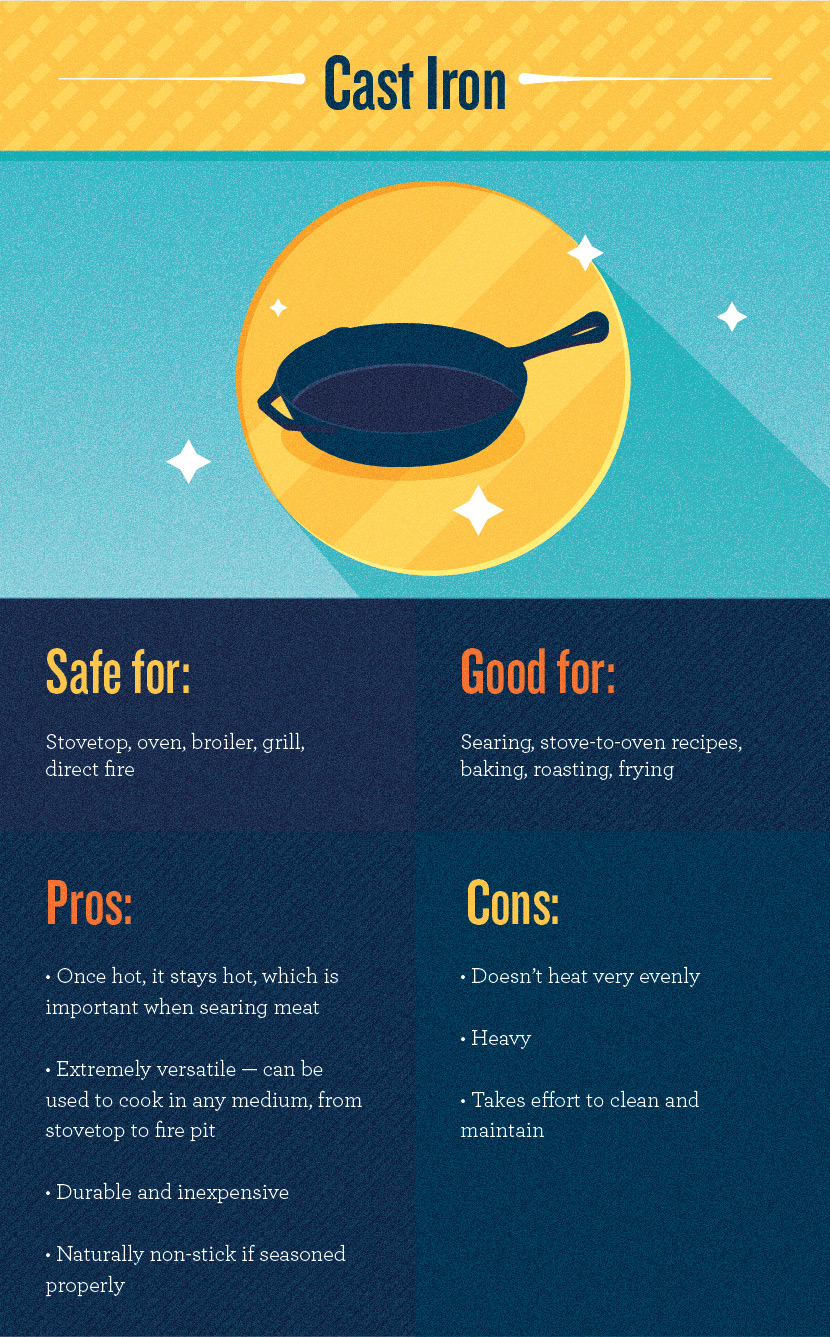
Enameled Cast Iron
Enameled cast iron offers many of the same benefits of classic cast iron, but without the hassle of seasoning. Plus, it’s much more attractive, and most models come in a wide array of colors. The only downside: enameled cast iron is significantly more expensive. The upside? Because the iron pot is lined with ceramic enamel, these items are non-reactive, meaning that home cooks can simmer tomato sauce without worry.
Enameled cast iron pots are heavy and take a while to heat through, but they do retain heat extremely well. These characteristics make enameled cast iron great for browning and transferring from the stovetop to the oven.http://www.kitchengallerymadison.com/2013/08/whats-the-difference-between-various-stovetop-cookware-materials/
How to clean it: Soap and water should do the trick. For tough spots, soak the pot with some soap and water, and gently rub it away with a plastic scrub brush. Do not use steel wool or other abrasive cleaners or tools. Most often, enameled cast iron is dishwasher safe. However, repeated dishwasher use can wear away at the coating.
Pros:
- Non-reactive coating allows for long, slow cooking of acidic and alkaline foods.
- Doesn’t require seasoning.
- Excellent heat conduction and retention.
- Very durable and cooks well over high heat.
- Visually appealing and comes in many different colors to match any kitchen.
Cons:
- Does not have a nonstick coating and, unlike regular cast iron, cannot develop non-stick characteristics through seasoning.
- Enameled cast iron is very heavy, which can make for tough handling.
- More expensive than traditional cast iron.
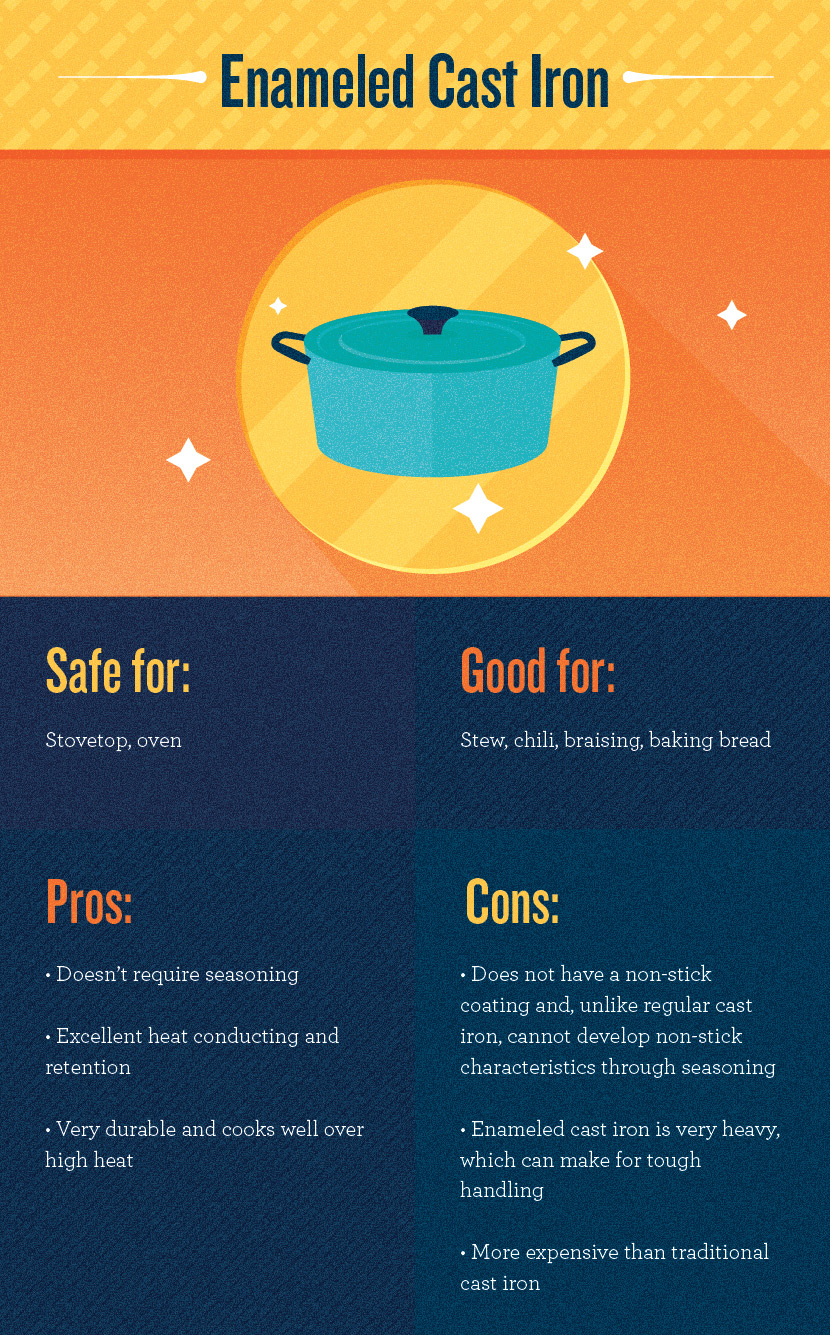
Stainless Steel
Stainless steel is non-reactive, durable, dishwasher-safe, and resistant to rust, corrosion, scratching, and denting. It’s also pretty easy on the eyes. However, on its own, stainless steel is a terrible heat conductor. The key to finding good stainless-steel cookware is to pick a model that has a core of another type of metal that conducts heat more effectively – most often aluminum or copper.
Aluminum-core pots and pans are more affordable than copper-core. However, copper is a slightly better conductor of heat compared to aluminum, which explains the price difference. Copper-core pans react more quickly to temperature changes, giving the cook more control over the cooking process.http://www.kitchengallerymadison.com/2013/08/whats-the-difference-between-various-stovetop-cookware-materials/
It’s also possible to find stainless steel baking pans, but unless they are reinforced with another type of metal that conducts heat more efficiently, opt for other materials.
How to clean it: Gently scrub with soap and water. When faced with tough burnt-on stains or debris, try this method: Fill the burned pot with water and boil for 15-20 minutes. Once loosened, scrape up stuck-on spots with a wooden spoon. Pour out the water, and wash the pot as normal.http://www.thekitchn.com/how-to-clean-burnton-stains-fr-107750 (For even tougher stains, coat the bottom of the pan with baking soda or a stainless-steel cleaner – such as Bar Keeper’s Friend – and scrub.)
Pros:
- Non-reactive.
- Durable.
- Less expensive than other options, such as copper.
- Dishwasher-safe.
Cons:
- Poor heat conductivity relative to other materials unless reinforced with aluminum or copper.
- Can be expensive, especially with copper core.
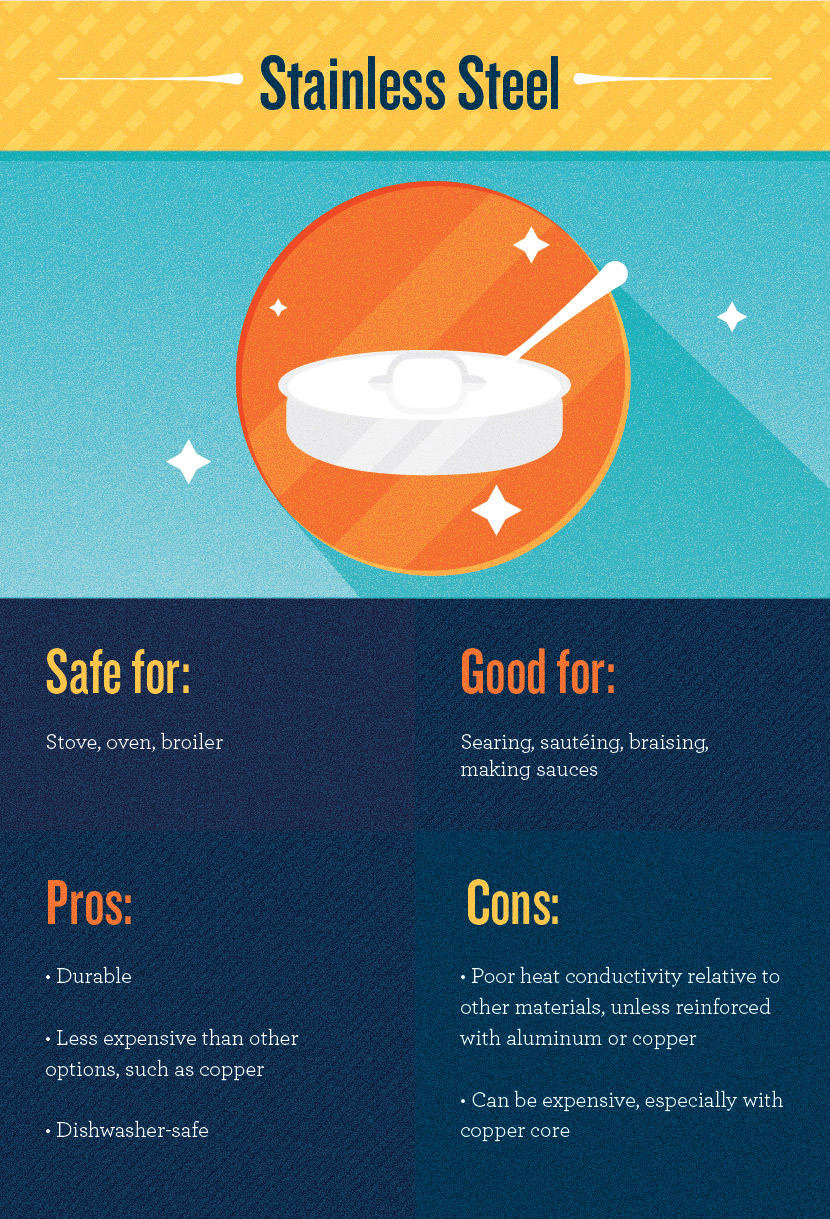
Carbon Steel
Use on: Stovetop, oven, broiler.
Good for: Omelets, meats, vegetables, layer cakes, loaf breads, cakes.
Most popular sizes: Start with a small frying pan (eight inches) and a wok. (If available, try a wok set, which comes with a domed lid and utensils specifically made for cooking in the unique slope-sided vessel.) For the oven, invest in a set of good cake pans and a loaf pan.
What to make: Jaques Pepin’s Classic French Omelet, Zucchini Bread, Cappuccino Layer Cake
Think of carbon steel pans as a cross between cast iron and stainless steel. They are typically about half the cost of stainless steel and twice the price of cast iron.http://zesterdaily.com/cooking/why-carbon-steel-pan-is-best-for-high-heat-cooking/ Like cast iron, carbon steel pans need to be seasoned and get better with age. They should never be left sitting in water or put in the dishwasher.
Carbon steel baking pans and woks are pretty easy to find, but frying pans can be a bit trickier (look at cooking supply stores or online). While carbon steel frying pans and woks behave more like cast iron and must be cared for similarly, carbon steel baking pans are typically coated with a nonstick or stick-resistant layer, which makes them easier to maintain. Adhere to manufacturer instructions for proper care.
How to clean it: Like cast iron, don’t place carbon steel in the dishwasher, and don’t leave it to sit in the sink with water or soap. Instead, gently wash with soap and water, and scrub any stuck-on spots with a plastic scrub brush or sponge. Dry completely, and re-season according to manufacturer directions.
Pros:
- Naturally somewhat non-stick.
- Lighter than cast iron, but offers many of the same characteristics.
- Reacts quickly to temperature changes and can withstand high heat.
- Lighter than cast iron (but slightly heavier than aluminum, stainless steel, and copper).
- Excellent heat conductor.
- Durable and affordable.
Cons:
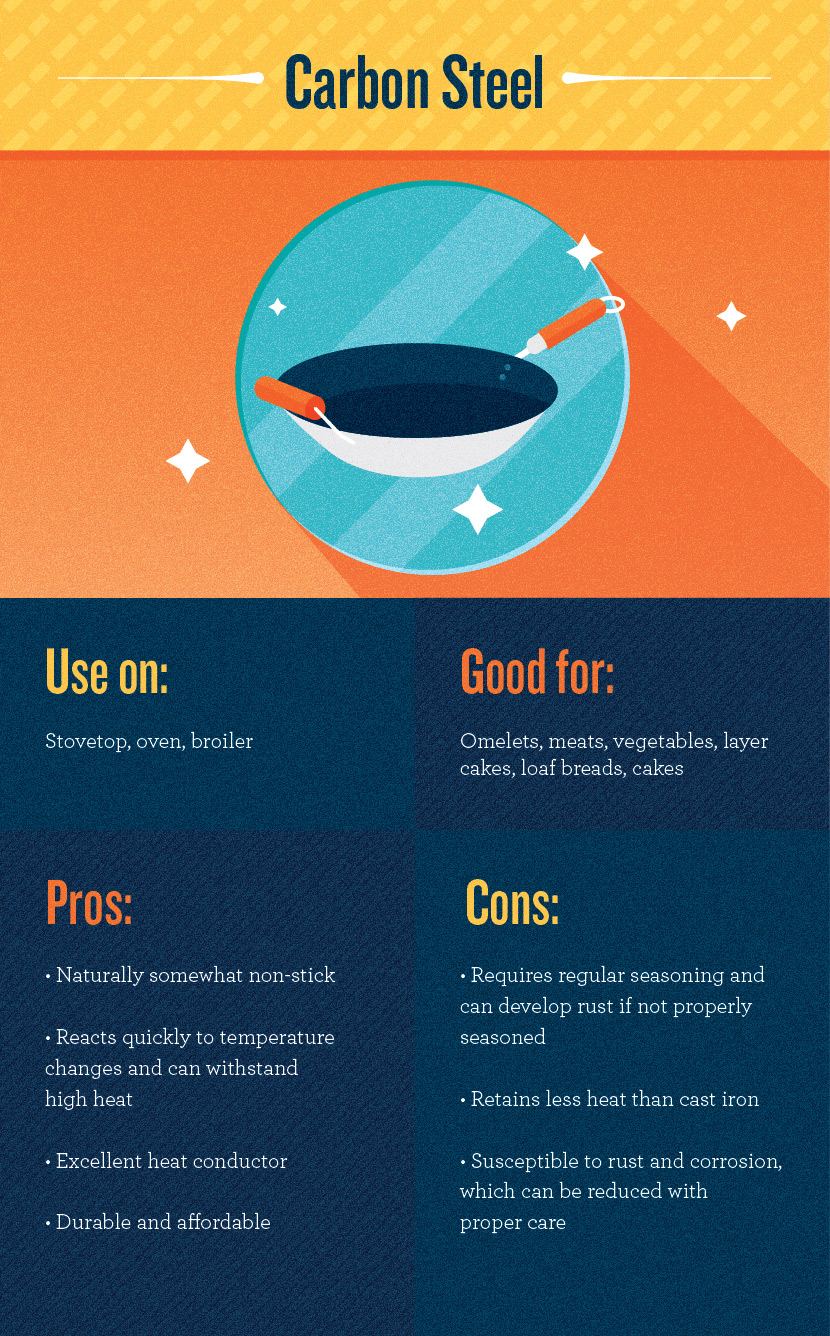
Copper
Safe for: Stovetop, oven, broiler.
Good for: Copper pots and pans can be used for most jobs, though they don’t react well to high heat. Try boiling, steaming, sautéing, or braising.
Most popular sizes: A good medium-to-large sauté pan and saucier would be a good starting point.
What to make: Mushroom Risotto, Concord Grape Jam, Homemade Salted Caramel Sauce
Copper is a fantastic heat conductor, which is one of the reasons that copper cookware is more expensive than its competitors. Copper heats and reacts to temperature changes quickly, giving the cook more control and making it easy to cook food evenly. Because copper is a reactive metal, it must be lined with another material, such as stainless steel or tin. There are some non-lined copper cookware pieces on the market, but these are specifically meant for sugar cookery, in which reactiveness is not an issue.http://hitchhikingtoheaven.com/2010/06/is-it-safe-to-make-jam-in-a-copper-pan.html While copper is not ideal for high-heat cooking, this is not a huge downfall. Because it’s so good at retaining and distributing heat, there is generally no need for a high flame.http://food52.com/blog/4728-cooking-in-and-caring-for-copper#HBqiw2:L9I
How to clean it: Wash with soap and water, and scrub with a gentle plastic brush. Do not use steel wool or abrasive cleaners. Over time, the copper outside of the pan will age, or patina. While some prefer this aged look, it’s also easy to polish away with a copper cookware cleaner or a number of homemade remedies.
Pros:
- Of all the cookware materials, copper is the best heat conductor. It heats food evenly and adjusts to temperature changes quickly.
- Does not require much pre-heating since copper heats very quickly.
Cons:
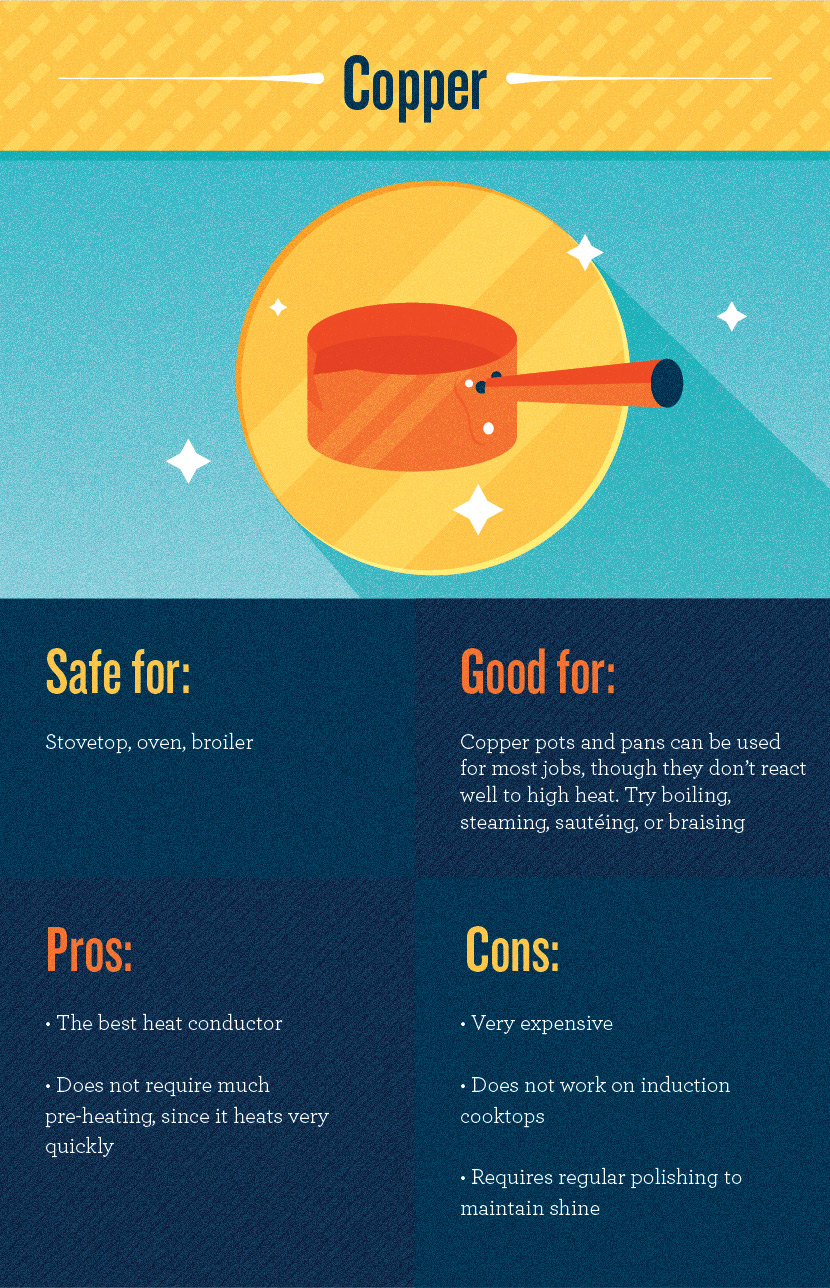
Aluminum
Safe for: Stovetop, oven.
Good for: Depending on the type of pan, eggs, fish, searing, sautéing.
Most popular sizes: Anodized aluminum pans are a less expensive alternative to stainless steel, so, depending on what is already in your kitchen cabinets, a set of frying pans (varying sizes) may be a good addition. Consider an anodized aluminum roasting pan with rack, as well. Aluminum is also used to improve the heat-conducting characteristics of steel baking pans – start with a set of large sheet pans.
What to make: Spring Vegetable Sauté, Roast Beef and Onions, Soft and Chewy Chocolate Chip Cookies
Because raw aluminum is an extremely soft and reactive metal, it must be processed in certain ways before it’s used as cookware. Anodized aluminum – which makes up the majority of the aluminum cookware out there – has been treated with a chemical process to harden the metal and make it non-reactive.http://www.thekitchn.com/a-guide-to-the-best-material-for-pots-and-pans-pros-cons-168241
Aluminum is also a popular material for bakeware, but it is almost always paired with another type of metal to increase durability. Aluminized steel baking pans and sheets are very popular among professional bakers thanks to their durability, great heat transfer, and corrosion-resistance.http://www.usapans.com/faq.html
How to clean it: Anodized aluminum can be cleaned much like stainless steel – soap and water, a plastic scrub brush for tough spots, and no harsh cleaners or steel wool. Most anodized aluminum will be dishwasher safe, but check with the manufacturer to be sure.
Pros:
- Excellent thermal conductivity.
- Lightweight and affordable.
- Scratch-resistant and strong.
- A better heat conductor than stainless steel. This is a benefit both for cooking foods on the stovetop and for achieving more evenly baked items in the oven.
Cons:
- Regular anodized aluminum will not work on induction burners. However, many manufacturers make aluminum cookware specifically outfitted to work on induction stovetops (make sure to double check before purchasing).
- May not be the best for sweet baked goods, as dark-colored metals can cause over browning if not watched closely.
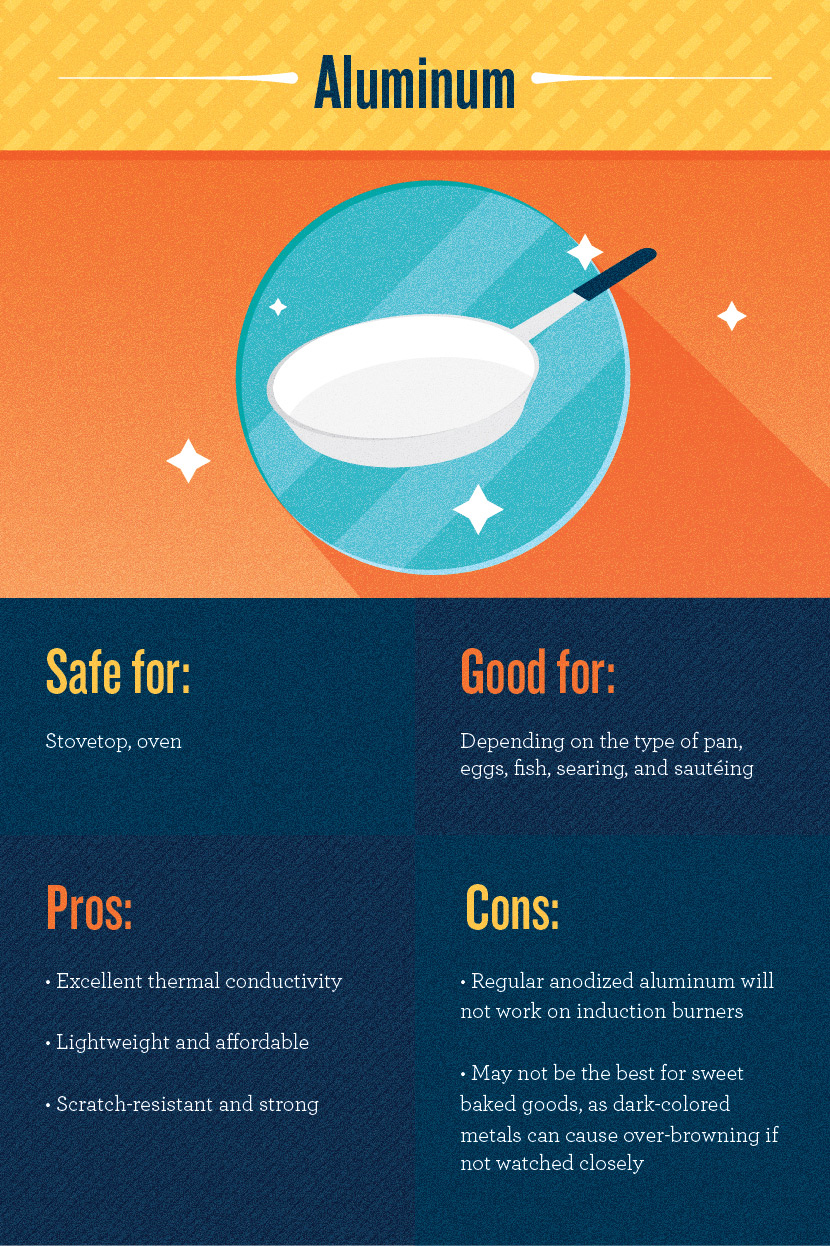
Non-Stick
Safe for: Stovetop. Some non-stick pans are also oven-safe up to a certain temperature; check with the manufacturer to be safe.
Good for: Non-stick pans are ideal for items that stick easily, such as eggs, delicate fish, and crepes.
Most popular sizes: Start with a medium skillet – we recommend a 10- or 12-inch. A smaller skillet can also be helpful when cooking for one.
What to make: Sunday Frittata, Chicken and Apple Egg White Omelet, Quick and Easy Crepes
While non-stick pans are not ideal for all jobs, they do have their place. They allow cooking with less fat and are also much easier to clean compared to other non-lined metal cookware.
Non-stick pans can be made from the same types of metal as other cookware – stainless steel, aluminum, and copper, for instance. The only difference is that the cooking surface is coated with a non-stick compound. The most common metal for non-stick pans is anodized aluminum because it is lightweight, affordable, rust-resistant, and a good heat conductor, which means that it reacts quickly to changes in cooking temperature. Teflon, a nonstick coating made from food-grade PTFE, a.k.a. polytetraflouroethylene, is the most commonly found non-stick coating, though other more eco-friendly options have gained popularity in the last few years.http://www2.dupont.com/Teflon/en_US/products/safety/what_is_it.html While nonstick coatings, specifically Teflon, have gotten a bad rap because of safety concerns, the majority of research on the subject says that non-stick pans are safe as long as they’re not overheated.http://www.goodhousekeeping.com/product-reviews/cooking-tools/cookware-reviews/nonstick-cookware-safety-facts (When overheated, the coating may begin to break down, releasing toxic particles and gasses, some of which are considered carcinogens.) Over time, the coating on non-stick pans can begin to flake off. When this happens, it is time to replace the pan. However, while it may be a bit disconcerting to know you may have consumed a few flakes of chemical coating, no research has shown that it can cause you harm.http://www2.dupont.com/Teflon/en_US/products/safety/key_questions.html#q8
How to wash it: Do not use steel wool or any other abrasive cleaners on non-stick pans. Soap, water, and a soft sponge should clean up most messes. Remove any stubborn spots with a plastic scrub brush. Most non-stick pans are dishwasher safe, but check with the manufacturer to be sure. Regardless of the instructions, repeated dishwashing can wear down the lining over time.
Pros:
Cons:
- Must use plastic (nylon, silicone) or wooden utensils; metal utensils will scratch the non-stick coating.
- Can’t withstand super high heat. Non-stick coatings can break down at high heat, so keep non-stick pans at medium-high heat or below.
- Nonstick coating can have a short lifespan depending on the brand and how long it’s cared for. Most companies claim that non-stick pans will last a lifetime, or at least 5 to 10 years, but in practice, most cooks find that they replace non-stick pans every 2 to 4 years.http://www.foodrepublic.com/2011/11/07/trouble-non-stick-pans
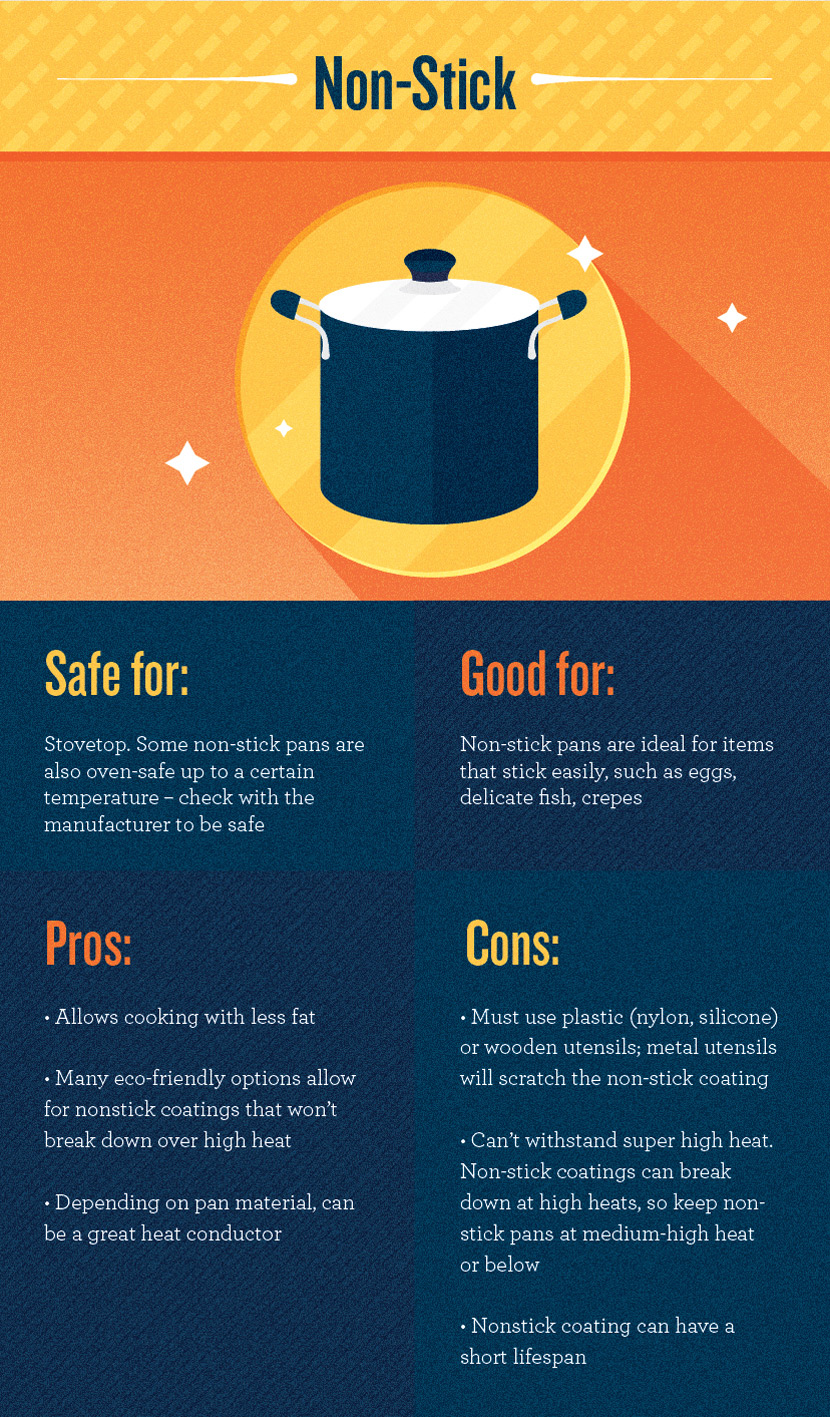
Glass
Glass baking dishes are versatile and make a great addition to any kitchen. Glass is non-reactive and conducts heat very well, which allows for great browning. While this is a desirable feature for savory casseroles where the browning of cheese or noodles is key or for pies where browning the crust is important, sugar-heavy dishes can over-caramelize in glass baking dishes. Glass baking dishes also work just fine for roasting vegetables or meats.http://www.thekitchn.com/metal-glass-ceramic-or-silicon-pans-when-to-use-each-169507
How to clean it: Glass is pretty resilient, so feel free to soak dirty pans and scrub away at tough spots with a plastic scrub brush or sponge. The one thing that can ruin a glass dish is heat shock. Let dishes cool completely before running under cool water. Glass bakeware is also dishwasher safe.
Pros:
- Non-reactive, so you can cook anything in them and store food right in the pan without worrying about developing off flavors or colors.
- Great heat conductor.
- Less expensive than ceramic.
Cons:
- Not safe for broiling. High temperatures may cause glass to shatter.
- Can conduct heat too well for sweet items and may cause sugar to burn.
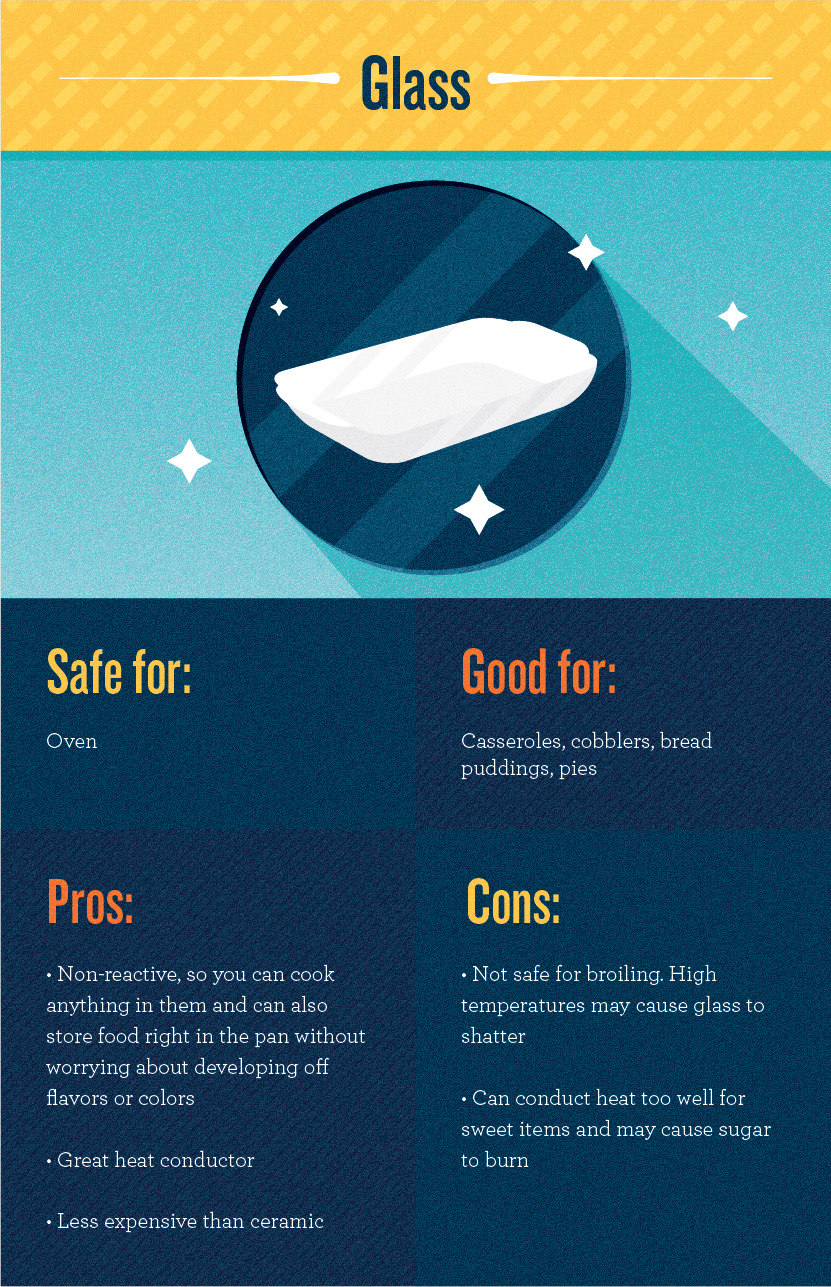
Ceramic
Safe for: Oven.
Good for: Casseroles, pies, and gratins.
Most popular sizes: Start with a medium (8x8 inch) and large (9x13 inch) casserole dish. Other great options include individual ramekins and gratin dishes.
What to make: Lasagna, Blueberry Peach Pie, Eggplant and Zucchini Gratin
Ceramic baking dishes come in many shapes and sizes. Ceramic heats up gradually, so it is ideal for dishes that need slow, even cooking (think custards or baked noodle dishes such as lasagna).http://www.foodandwine.com/articles/best-baking-dishes Ceramic is also non-reactive, so it is perfect for cooking acidic and alkaline foods, as well as storing food after baking. Ceramic baking dishes are also visually appealing, making them a great option for oven-to-table serving.
How to clean it: For extra-dirty ceramic dishes, wait for dish to cool. Soak with water and soap until residue releases from pan. Scrub stuck-on spots with a plastic brush or sponge. Most ceramic is also dishwasher safe.
Pros:
- Non-reactive, so it is good for acidic foods such as tomatoes.
- Heats slowly to prevent over-browning.
- Dishes look pretty.
- Food can also be served in baking dish.
- Smooth glaze is almost nonstick.
Cons:
- Can over-brown sweet items.
- Can break more easily than other cookware.
- Chips easily.
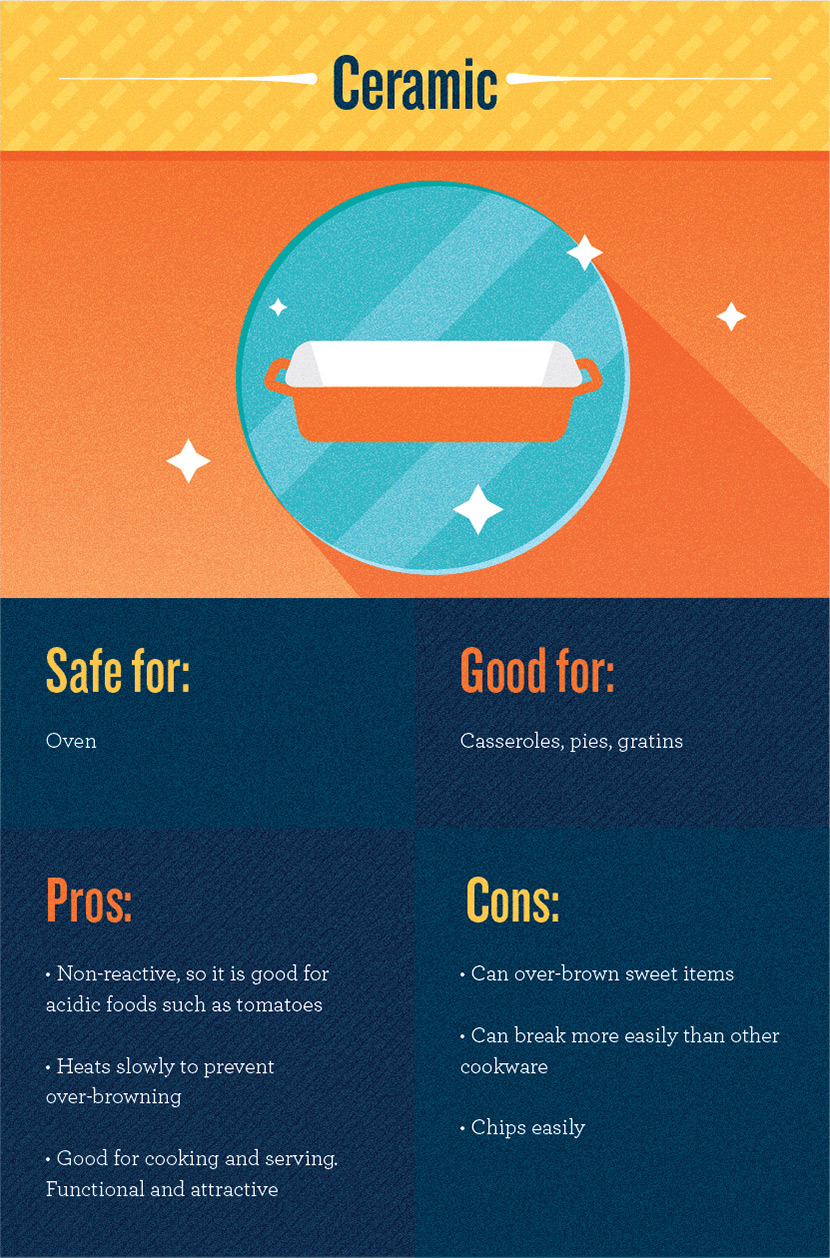
Silicone
Safe for: Oven.
Good for: Light-colored cakes, breads, and muffins where sticking is an issue.
Most popular sizes: The single most useful silicone bakeware item is a silicone sheet pan liner. In addition, a 12-hole muffin pan and/or a set of cake pans may prove useful.
What to make: Vanilla Cupcakes, Molten Chocolate Babycakes
In recent years, all sorts of silicone baking products have hit the market, from pan liners to muffin “tins” and cake pans. The one must-have silicone oven product is the pan liner or mat. These liners allow cookies, galettes, and pizzas to slide right off without sticking. Outside of the oven, these mats are great for rolling out dough without excess flour to prevent sticking. Silicone muffin pans or other silicone molds are also helpful for no-bake treats, such as chocolate mousse bombs. Though silicone bake ware is generally nonstick, it can sometimes be hard to un-mold certain recipes, and they can be a pain to wash clean. Avoid products with waffled or textured interiors. The more textured the surface is, the harder it will be to clean.
How to clean it: Soap, water, and a soft sponge should do the trick. Silicone baking molds are also dishwasher safe.
Pros:
- Prevents sticking.
- Usually easy to remove baked items from the mold. However, edges and corners can sometimes get stuck.
- Dishwasher safe. However, a trip through the dishwasher alone may not remove all of the residue from the mold.
- Great for homes with limited storage space, as they can be folded up and tucked away.
Cons:
- Poor heat conductor.
- Baked goods tend not to brown well; this can be good or bad, depending on the recipe.
- Can be frustrating to clean. While nothing really sticks to the silicone, there is always a slight film left, which can be hard to completely remove.
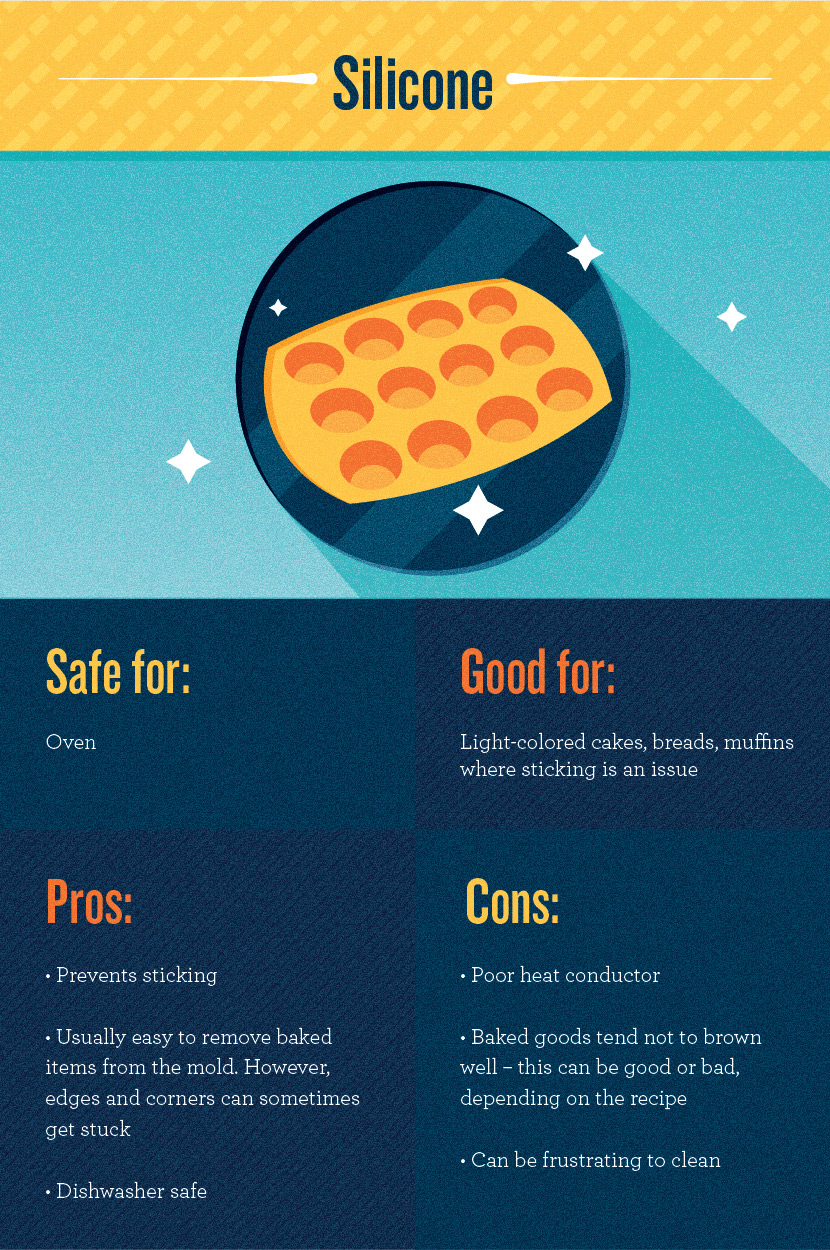 As you can see, the decision regarding which cookware is right for the meal you intend to cook is not always as simple as it might seem. Use the above tips to take some of the mystery out of the equation and make your meals the best they can be, every time.
As you can see, the decision regarding which cookware is right for the meal you intend to cook is not always as simple as it might seem. Use the above tips to take some of the mystery out of the equation and make your meals the best they can be, every time.
Embed the article on your site

